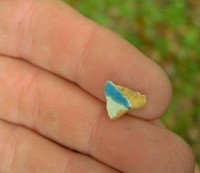Milam County Historical Commission
Milam County, Texas
Milam County, Texas






Find excites area researchers
by Jeanne Williams
Temple Daily Telegram - March 14, 2009
Dr. James Bruseth holds a fragment of Majolica pottery that
was found Wednesday at the suspected site of the Nuestra Senora
de la Candelaria mission near Apache Pass.
(Shirley Williams/Telegram)
APACHE PASS - A tiny shard of Majolica pottery lying on topsoil was reason for
celebration this week.
Dr. James “Jim” Bruseth, Texas Historical Commission archaeology division director,
declared the earthenware fragment a valuable clue to researchers eager to pinpoint the
location of the lost 18th century Spanish mission Nuestra Señora de la Candelaria, one
of three that existed in the mid-1700s in southwest Milam County.
“Only Spanish missionaries would have dropped a piece of pottery at that site,” Bruseth
said.
Pottery fragments, documents from archives in Spain, and data gleaned from Dr. Kathleen
Gilmore’s 1969 archaeological expedition, plus magnetometer readings from a three-day
site visit to Milam County this week will direct the historical commission team toward
underground mission sites to be excavated later, Bruseth said.
Two historical commission crews were at work in the cold mist Wednesday morning; one
team surveying a field off FM 908 using a magnetometer - a supersensitive metal
detector that measures magnetism at 1 meter deep; the other excavating soil at the site
scientists believe once housed the Candelaria mission.
The magnetometer can detect magnetic deposit in the soil by human habitation, and
hopefully the presidio. The instrument detected magnetism but results were
inconclusive.
The magnetometer scanned an open field off FM 908 Wednesday, detecting what
archaeologists wanted to see - an acre-sized linear image in the shape of a rectangle
that could be the site of the presidio, Bruseth said, adding that archaeologists were
taking a conservative stand in determining if the magnetometer actually detected the
presidio site.
Additionally, the scanner detected specific artifacts in the field. “We don’t know what
they are, but they are there,” Bruseth said. The next step will be using a back hoe to
dig at meter-depth to search for artifacts, he said.
The research Wednesday at the suspected Candelaria mission site yielded some relics
ranging from the 1840s to the mid-20th century in addition to the 18th Century pottery
fragment. Archaeologists at the San Ildefonso Mission encountered evidence that the
soil had been disturbed and the hard ground was difficult to dig, he said. No artifacts
were found at the suspected site, Bruseth said.
The team may return to the San Xavier Missions site in April or May, he said.
“There are future discoveries that will be made out there,” Bruseth said.
Dr. Gilmore, 94, a retired archaeologist and college professor, has some unfinished
business at the San Xavier Missions. She returned this week as senior adviser on this
week’s archaeological expedition and to satisfy a personal interest in Spanish colonial
archaeology that has consumed countless hours of research at historical sites and in
the archives of Spain. Dr. Gilmore said she would not have missed the latest site
visit.
“Having done the original work for this, to find this site and understand it, she is
indispensable and she knows all the history behind it,” Bruseth said.
Dr. Gilmore discovered the San Francisco Xavier de Horcasitas mission during an
excavation in 1969, but archaeologists have yet to find the exact sites of the missions
San Ildefonso and Candelaria.
“This area in Milam County is very important archaeologically in that we have three
Spanish missions built here in the mid 18th century,” said Bruseth, who led the
unprecedented underwater excavation in 1997 of the 1687-storm scuttled French ship
Belle in Matagorda Bay on the Texas coast.
Historical documents placed Mission San Francisco on a hill by the third meadow beyond
Apache Crossing; Mission Candelaria two gun shots from Mission San Francisco; and the
San Ildefonso Mission one league down river east from San Francisco. The presidio was
on the third meadow downstream from Apache Pass.
Archaeologists think “we know where they are, but we haven’t been able to verify, and
we haven’t found the Spanish presidio,” Bruseth said.
The San Xavier Missions brought Christianity to numerous tribes of Central Texas
Indians from 1746 to 1755 near the San Gabriel River, then called the San Xavier River.
Lipan Apaches not only were hostile to other tribes, but to the Spanish missionaries,
and raided the settlements near the river crossing now known as Apache Pass. The San
Xavier missions were closed and moved after conflict between the soldiers and
missionaries, Apache raids, prolonged drought and diseases - becoming lost historical
sites.
Renewed interest in the San Xavier Missions of Milam County was prompted by attention
to the El Camino Real De Los Tejas Historical Trail - a 2,500-mile long corridor that
linked Mexico City with Los Adaes, the provincial capital of Texas from 1722 to 1772,
Bruseth said.
.

All articles from the Temple Daily Telegram are published with the permission of the
Temple Daily Telegram.
All credit for this article goes to
Jeanne Williams and the Temple Daily Telegram
Photos by Shirley Williams -
Temple Daily Telegram photographer
Temple Daily Telegram.
All credit for this article goes to
Jeanne Williams and the Temple Daily Telegram
Photos by Shirley Williams -
Temple Daily Telegram photographer